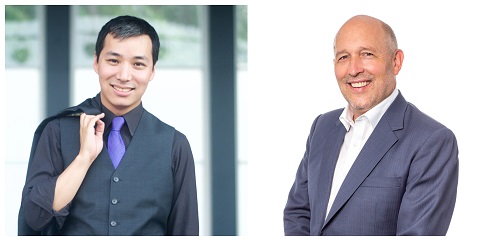Mentors Push Young Leaders Ahead
By Lisa Traiger

Photo credits: Bonnie Holmes and Cheryl Mann. Courtesy of Warburton and Cameron.
Interns, recent graduates and early-career arts administrators aren’t the only ones who benefit from a mentor. Just ask David Warburton. By the looks of his bio and resume, Warburton steadily progressed from stage manager for small theater companies to production manager at the 2,600 capacity Malkin Bowl and other semi-permanent summertime venues in Vancouver to a three-and-a-half-year stint as company manager at Royal Winnipeg Ballet. These days he’s director of national and international touring and business development at the Canadian company. He has worked with organizations ranging from Electric Company Theatre, Boca Del Lupo and American Conservatory Theater to Vancouver’s Theatre Under The Stars, and the 2010 Winter Olympic and Paralympic Games.
At 32, Warburton’s career trajectory seems to be on a pretty steady rise, yet he felt he could use a little outside perspective and consultations with those further along on their career paths. The Dance/USA Institute for Leadership Training’s (DILT) national dance mentorship program fit the bill, matching Warburton with Greg Cameron, president and CEO of the Joffrey Ballet, for a nine-month period.
The overarching goal of DILT is to build the leadership and decision-making skills of early-career dance leaders who represent the diversity of the national, professional dance community. DILT emphasizes regular communication between established leaders (mentors) and early-career leaders (mentees) to foster self-direction and self-reflection. The program was designed to enhance and refine the skills of emerging leaders within the dance field so that they may guide dance organizations through the future’s challenges and shifting landscapes.

Some of the 2018 DILT mentees (left to right: Kayla Hamilton, Niya Nicholson, David Warburton, Kim Savarino). Courtesy: David Warburton
“When I moved into my current position at Royal Winnipeg Ballet,” Warburton said, “the company had been operating without an executive director or a director of finance for over a year. Just the artistic director and a handful of senior staff, including myself, were keeping the organization alive and afloat. I really felt with my new responsibilities that I wanted to upgrade my skills … for the new tasks I was taking on. I wanted to find somebody who could help me, guide me through that process.”
Greg Cameron has served as The Joffrey Ballet’s president and CEO since 2013. Prior to that the Chicago-native raised funds for the Chicago Department of Cultural Affairs, the Art Institute of Chicago, the Museum of Contemporary Art, where he became deputy director and chief development officer, and WTTW/WFMT, where he was COO. “There were multiple times early on in my career,” Cameron reflected, “when somebody helped me get on my feet.” So when Dance/USA approached him about mentoring, he didn’t hesitate. It was his turn to pay it forward.
He notes that early in his career, he learned an important lesson from his own mentor, Janet Carl Smith, former deputy commissioner of Chicago’s Department of Cultural Affairs: “Asking for help is a strength, not a weakness. We can’t always have all the answers, that’s where colleagues and mentors come in.”
Cameron also found that when the chemistry is right, a mentorship can develop into a friendship. That’s what happened with him and Smith. Smith concurred, stating, “I’m proud to have been Greg’s mentor, and we talk about the fact that we now mentor each other! Personally, I believe that mentoring is a two-way street, especially these days, as those of us who’ve been in the workplace for years have much to learn from the technology natives who now are assuming positions of responsibility in our field.”
And that seems to be happening with Warburton as well. While mentor and mentee speak by telephone about every four weeks and Warburton traveled to Chicago for a brief but intense site visit earlier this year, both men already feel that they will remain in touch after the nine-month-long DILT program concludes. For Warburton’s site visit to Chicago, Cameron arranged quite a schedule, including a meeting with the Joffrey’s leadership team and breakfast with the company’s board president, plus meetings with and tours of other major Chicago arts organizations, including the Chicago Lyric Opera and the Steppenwolf Theatre. “I wanted to give David a broader sense of the cultural landscape in the city and how that impacts my work,” Cameron explained.
But Warburton wasn’t the only one to benefit during his site visit. Cameron shared that although his mentee was just observing a meeting with the marketing department about a proposal for lobby video displays, Warburton had some money-saving ideas drawn from his expertise with technology applications. And while Cameron has decades of experience working for arts and cultural organizations, he admitted he’s not as technically aware as his younger colleagues. As well, he added, “I’m still relatively new to the dance world, and there are some things I don’t know. I plan to get up to Winnipeg to see David in action” when their busy schedules permit.
As for Warburton, having a mentor who works in the ballet world has been helpful: “During Nutcracker season we were able to commiserate about the pains. And we go through the same success and joy as well. We also shared the same excitement about things like various choreographers in the ballet world.”
Beyond the regular phone calls and the site visit, Warburton found that connecting with the current class of DILT mentees was equally valuable. “I went into [DILT] thinking it was a mentorship opportunity. I was looking for a lot of high level organizational and leadership mentoring.” He found that when he and Cameron connected. But as an added bonus, Warburton said, “Sometimes it feels like other parts of the country are a continent away. Dance/USA’s mentorship program allowed me to meet all of these emerging leaders who have these incredible resumes …. The talks we had about some issues, like inclusivity, diversity and equity, were really refreshing.”
“When I was around like-minded people who are in the same stage of development in their career, I felt a little bit less alone,” he added.
As the 2019 DILT mentorship program comes to a close, Warburton reports that he and his fellow mentees plan to stay in touch and find ways to build on these connections. “There are all sorts of incredible people of our generation working in the arts or just coming in [to the field],” he said. “It would be really great to make those contacts and connections and build for the future.” As the DILT program enters its tenth year, an alumni network of mentees is in the works. “There’s just such an opportunity for our own network,” Warburton said, “to build on our connections and keep moving forward.”
For more on the DILT program, visit the Dance/USA Institute for Leadership Training. Learn more about the 2018 mentees and 2018 mentors.
 Lisa Traiger edits From the Green Room, Dance/USA’s online journal, and writes frequently on dance and the performing arts for a variety of publications including Dance, Dance Teacher, Washington Jewish Week and DCDanceWatcher.
Lisa Traiger edits From the Green Room, Dance/USA’s online journal, and writes frequently on dance and the performing arts for a variety of publications including Dance, Dance Teacher, Washington Jewish Week and DCDanceWatcher.
____
We accept submissions on topics relevant to the field: advocacy, artistic issues, arts policy, community building, development, employment, engagement, touring, and other topics that deal with the business of dance. We cannot publish criticism, single-company season announcements, and single-company or single artist profiles. Additionally, we welcome feedback on articles. If you have a topic that you would like to see addressed or feedback, please contact communications@danceusa.org.
Disclaimer: Opinions expressed in guest posts do not necessarily represent the viewpoints of Dance/USA.



